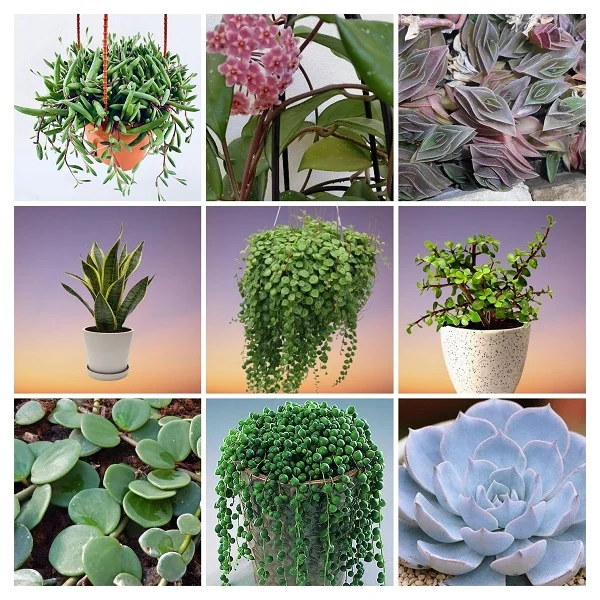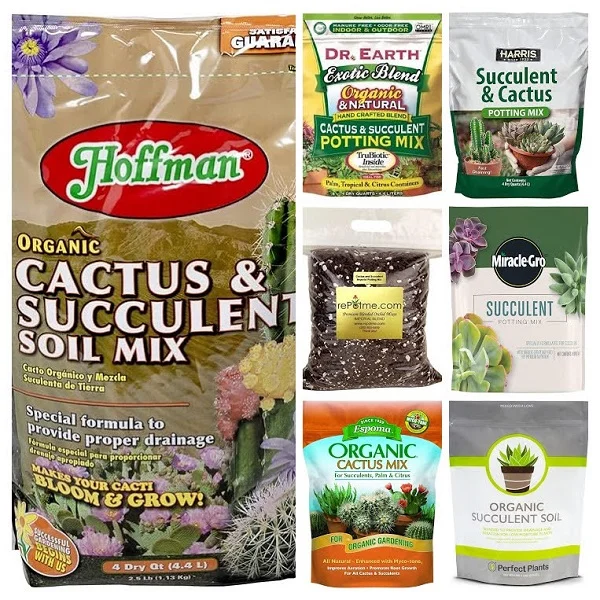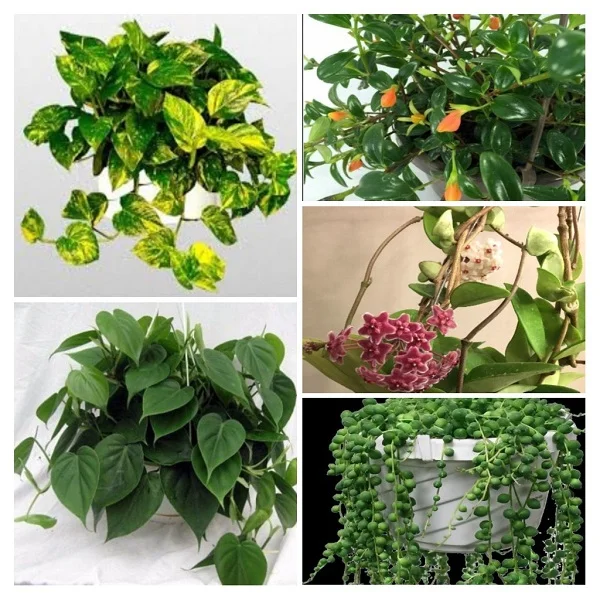14 Indoor Hanging Succulents with Names and Pictures
Some links in this post may be affiliate links
Succulent plants or simply succulents, are plants whose parts are thickened, fleshy, or engorged, which is an adaptation to arid climates.
Succulents store upto 60% water in these structures which enables them to survive long periods of dryness in their natural environment.
The word succulent comes from the Latin word sucus, which means 'juice', or 'sap' in reference to the plant sap contained in the thickened or engorged structures.
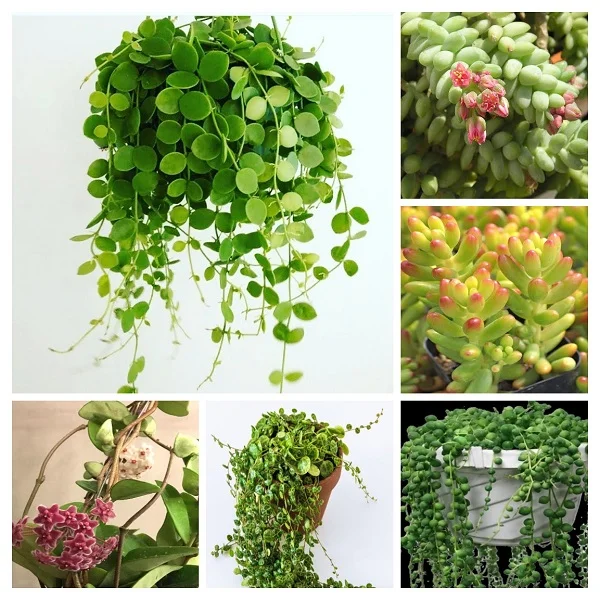
The engorged structures in succulents are usually the leaves or the stems where the plant stores large amounts of water which comes in handy during the dry periods.
Succulents are often grown as indoors because of their striking, unusual appearance, as well as their ability to grow with minimal care.
Succulent Plants are relatively easy to grow and are considered ideal even for a beginner plant parent as they do not require very close attention.
Hanging Succulents usually have trailing or climbing stems which cascade beautifully down the sides of a pot or a hanging basket. They also look beautiful on a pedestal or high up on a shelf or on a table top.
We have herebelow listed for you 14 of the best hanging succulents that you can grow indoors and outdoors successfully if you give them the right growing conditions.
14 Hanging Succulent Types for Indoors
Best hanging succulent plants are String of Bananas Plant, Christmas Cactus, Donkey's Tail Plant, Watch Chain Plant, German Ivy, String of Watermelons Plant, String of Turtles Plant, String of Nickels Plant, Trailing Kalanchoe among others.
1. String of Bananas Plant (Senecio radicans)
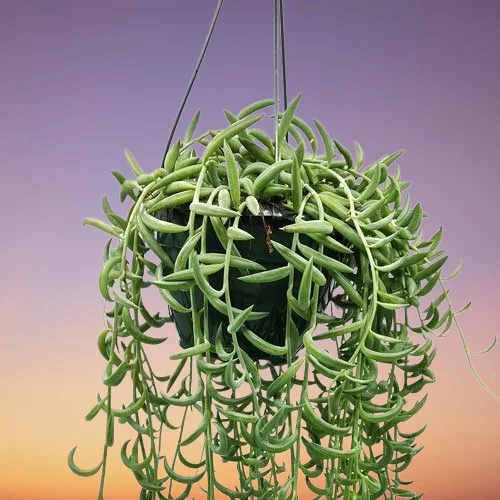
String of Bananas Plant also called String of Fishhooks is a unique succulent plant which bears pendant thread-like stems on which are tiny leaves shaped like small green bananas.
The odd shaped leaves in String of Bananas Plant like in its relative String of Pearls Plant (Senecio rowleyanus) are an adaptation to arid conditions and allows for the storage of water while exposing minimum surface area to the dry desert air.
Senecio radicans grows best in bright light with 6-8 hours of direct sunlight, warmth of 20-270C, humidity of 50-55% and moderately moist, rich, well drained succulents potting soil coupled with monthly feeding during the growing season.
Learn more on how to grow and care for String of Bananas Plant
2. Christmas Cactus (Schlumbergera x buckleyi)
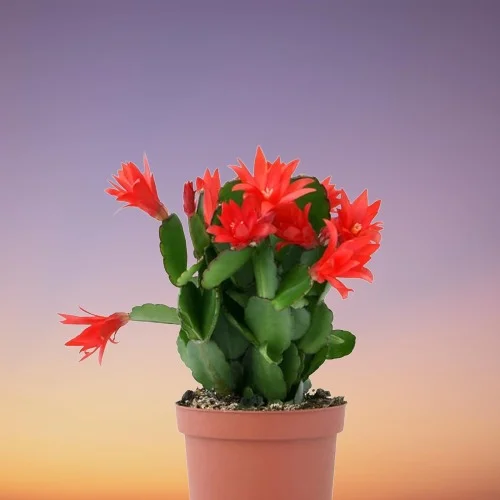
Christmas Cactus is a popular succulent plant with fleshy, flattened leaves which look like segmented stems. The original flower color is red but hybrids may come in pink, purple, white and other colors.
The fleshy, segmented stems in Christmas Cactus which bear flowers at the ends and are slightly serrated on each side hang downwards beautifully placing this plant among the best flowering plants for hanging baskets.
Schlumbergera x buckleyi blossoms in bright filtered light, warmth of 18-260C, humidity of 55-65% and moderately moist, rich, loose, free-draining cactus potting soil coupled with monthly feeding during the growing season.
Read more on how to grow and care for Christmas Cactus
3. Donkey's Tail Plant (Sedum morganianum)
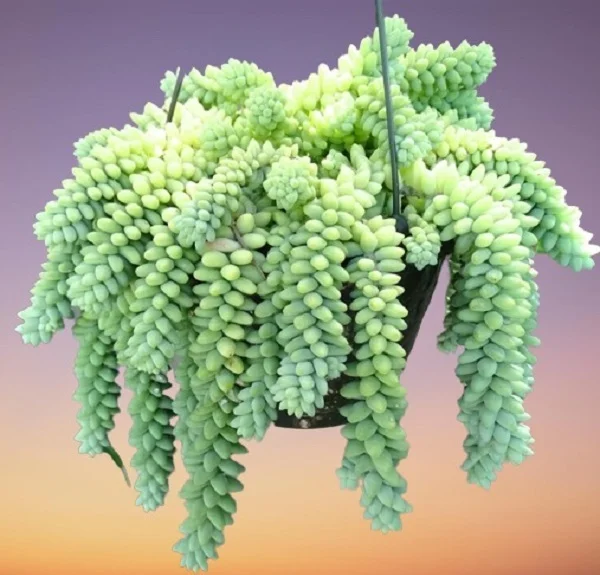
Donkey's Tail Plant also called Burro's Tail Plant is a trailing plant which bears 2-3 feet long stems, completely clothed with blue-green cylindrical succulent leaves.
With its spectacular cascading stems and terminal, pink to red flowers, Donkey's Tail Plant like Sedum pachyphyllum (Blue Jelly Beans Plant) and Sedum rubrotinctum (Jelly Beans Plant) is ideal for a hanging basket.
Sedum morganianum does best in bright light with 6-8 hours of direct sunshine, warmth of 18-260C, humidity of 50-55% and moderately moist, fertile, loose succulents soil coupled with monthly feeding during the growing season.
Learn more on how to grow and care for Donkey's Tail Plant
4. Watch Chain Plant (Crassula muscosa)
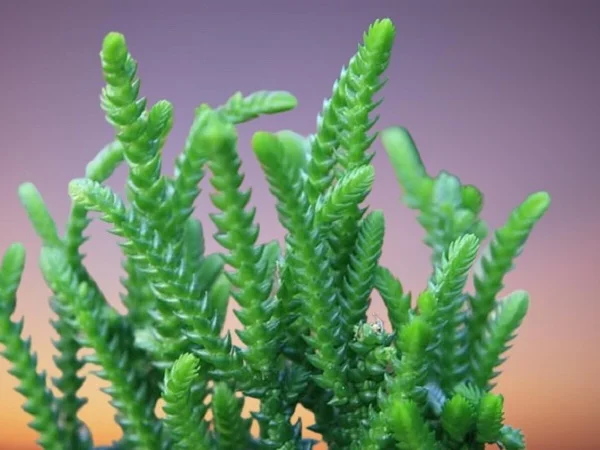
Watch Chain Plant also called Rattail Crassula, Clubmoss Crassula, Lizard Tail, Zipper Plant, Princess Pine is among the popular Crassula varieties with stems which start off erect but as they mature, they begin to trail due to the weight of the fleshy leaves.
Clubmoss Crassula and its cousins Crassula perforata (String of Buttons Plant), Crassula sarmentosa Variegata (Variegated Showy Trailing Jade) and Crassula rupestris (Crassula Baby Necklace Plant) are among the best hanging succulent plants.
Crassula muscosa blossoms in bright light with at least 4-6 hours of direct sunlight, warmth of 20-280C, humidity of 50-55% and moderately moist, rich, well-drained succulents soil coupled with monthly feeding during the growing season.
Learn more on how to grow and care for Watch Chain Plant
5. German Ivy (Senecio mikanioides)
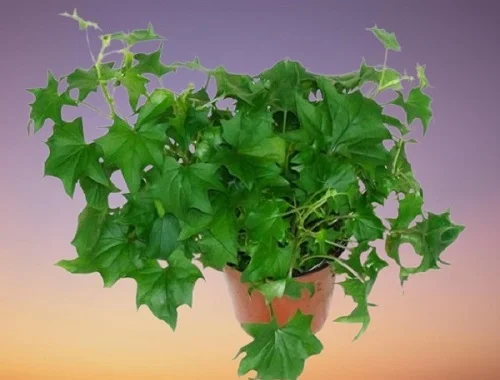
German Ivy also called Cape Ivy or Parlour Ivy is among the fast-growing, evergreen, climbing Senecio varieties and bears fleshy, glossy, lobed leaves and clusters of bright yellow daisy-like flowers.
The Cape Ivy stems like those of its relative Scrambling Groundsel (Senecio angulatus), can be allowed to hang downwards in a hanging basket or trained up a moss pole or a trellis.
Senecio mikanioides prospers in medium to bright indirect light, warmth of 18-270C, humidity of 50-55% and moderately moist, fertile, well-drained succulents potting mixes coupled with fortnightly feeding during the growing season.
Learn more on how to grow and care for German Ivy
6. Teddy Bear Ears Vine (Cyanotis kewensis)
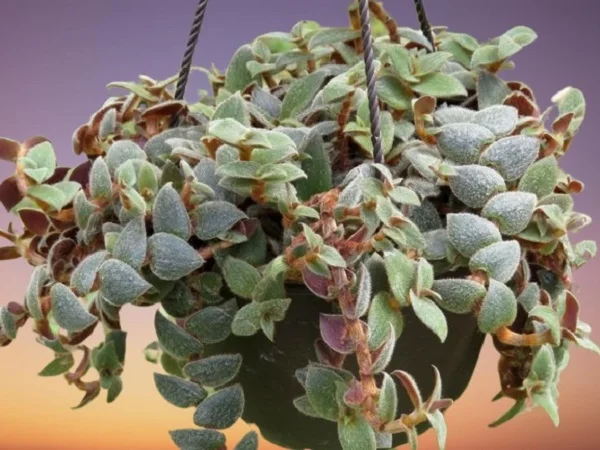
Teddy Bear Vine is a creeping succulent vine ideal for a hanging basket or a groundcover which bears oval-shaped leaves about 1 inches long which are hairy (velvet-like) with purple underside.
Teddy Bear Vine and its relative Pussy Ears Vine (Cyanotis somaliensis) are ideal for a hanging basket, a pedestal or a tall pot where the trailing stems can beautifully cascade downwards.
Cyanotis kewensis requires bright indirect light with 4-6 hours of morning sunshine, warmth of 15-270C, humidity of 50-55% and moderately moist, rich, succulents mixes and monthly feeding during the growing season.
Learn more on how to grow and care for Teddy Bear Vine
7. String of Watermelons Plant (Senecio herreanus)

String of Watermelons Plant also called String of Raindrops Plant or Gooseberryplant bears pendant thread-like stems on which are succulent, oval-shaped, dark-green leaves with purple stripes and resemble the rind of the watermelon fruit and hence the common name.
String of Raindrops Plant and its cousin String of Dolphins Plant (Senecio peregrinus) are some of the best sun-loving plants for a sunny spot on account of their need for exposure to some sunshine for them to thrive.
Senecio herreanus flourishes in bright light with 4-6 hours of direct sunshine, warmth of 20-270C, humidity of 50-55% and moderately moist, fertile, well-drained succulents soils coupled with monthly feeding during the growing season.
Learn more on how to grow and care for String of Watermelons Plant
8. String of Hearts Plant (Ceropegia woodii)

String of Hearts Plant also called Rosary Vine, Chinese Lantern or Chain of Hearts is an unusual succulent with sparsely spaced, heart-shaped leaves and insignificant tubular flowers.
Rosary Vine is among the popular string of plants and bears trailing stems and fleshy, grey-green leaves with an eye-catching marbled pattern and is ideal for a hanging basket.
Ceropegia woodii blossoms in bright indirect light (filtered light), warmth of 16-250C, humidity of 50-55% and moderately moist, rich, well-drained succulents potting soil coupled with monthly feeding during the growing season.
9. Trailing Jade Peperomia (Peperomia rotundifolia)

Trailing Jade Peperomia also called Trailing Jade Plant, Jade Necklace, Creeping Peperomia, Creeping Peperomia, Creeping Buttons or round Leaf Peperomia, is among the popular trailing Peperomia varieties and bears hanging shoots and very small, thick and fleshy, succulent, button-like leaves.
Trailing Jade Plant and its relatives Peperomia puteolata (Parallel Peperomia), Peperomia verticillata (Red Log Plant), Peperomia clusiifolia (Peperomia Ginny) and Peperomia scandens 'Variegata' are among the best plants for hanging baskets.
Peperomia rotundifolia prospers in medium to bright indirect light (dappled light), warmth of 15-260C, humidity of 55-65% and moderately moist, fertile succulents potting mix coupled with monthly feeding during the growing season.
Learn more on how to grow and care for Trailing Jade Plant
10. String of Nickels Plant (Dischidia nummularia)
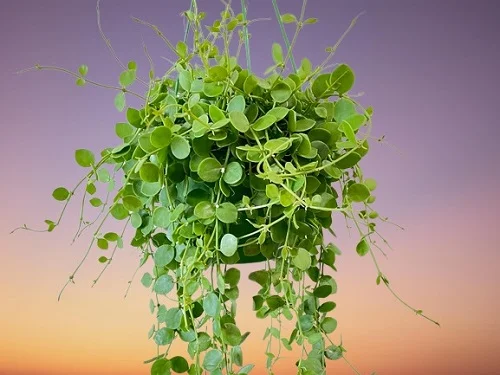
String of Nickels Plant also called Button Orchid is a trailing, succulent plant which forms a dense mass of greenish-yellow foliage with trailing stems growing upto 3 metres long. The leaves look-like numerous coins, hence the common name.
Dischidia nummularia belongs to the Apocynaceae family together with Million Hearts Plant (Dischidia ruscifolia) and Watermelon Dischidia (Dischidia ovata) which are popular plants for a hanging basket.
Dischidia nummularia prospers in bright light with 4-6 hours of morning sunshine, warmth of 18-260C, humidity of 50-55% and moderately moist, rich, well-drained succulents soil with two feedings during the growing season.
Learn more on how to grow and care for String of Nickels Plant
11. String of Rubies Plant (Othonna capensis)

String of Rubies Plant also called String of Pickles, Little Pickles or Ruby Necklace is characterized by reddish-purple stem and thin, oval-shaped leaves which turn a bright ruby red when the plant is grown under bright sunshine.
The odd shaped leaves in String of Pickles is an adaptation to arid conditions and allows for the storage of water while exposing minimum surface area to the dry desert air which greatly reduces water loss placing this plant among the best drought-tolerant plants for the home.
Othonna capensis thrives in very bright light with at least 6 hours of sunlight, warmth of 20-270C, humidity of 50-55% and moderately moist, fertile, well-drained succulents soil coupled with two feedings during the growing season.
Learn more on how to grow and care for String of Rubies Plant
12. String of Turtles Plant (Peperomia prostrata)
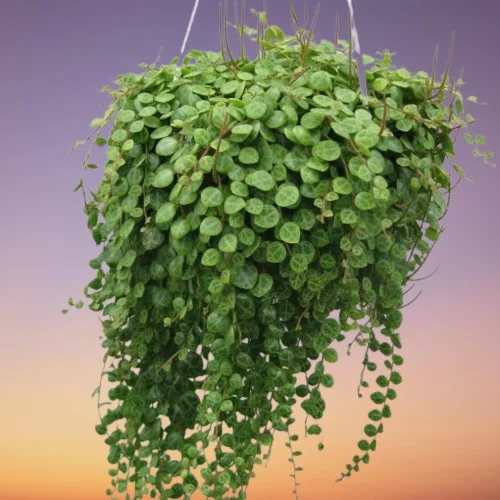
String of Turtles Plant also called Magic Marmer is one of the popular Peperomia varieties on account of its ease of care and ability to adapt to a wide range of growing conditions.
Magic Marmer and its cousins Peperomia obtusifolia (Pepper Face Plant), Peperomia polybotrya (Coin-leaf Peperomia), Peperomia argyreia (Watermelon Peperomia) and Peperomia orba (Teardrop Peperomia) are compact plants ideal for the limited spaces in the home, office and other places.
Peperomia prostrata thrives in bright light with 4-6 hours of direct sunlight, warmth of 18-250C, humidity of 50-55% and moderately moist, fertile, well-drained succulents potting soil coupled with monthly feeding during the growing season.
Learn more on how to grow and care for String of Turtles Plant
13. Trailing Kalanchoe (Kalanchoe uniflora)
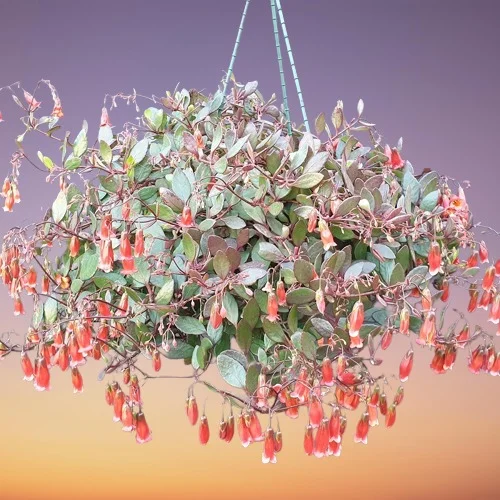
Trailing Kalanchoe also called Coral Bells, Coral Berry or Winter Bells is one of the succulent, climbing Kalanchoe varieties which bears fleshy, bright-green leaves and bright red to red-violet, bell-shaped flowers.
Coral Bells provides a spectacular display in a hanging basket or on a pedestal where the pendulous stems and colorful flowers can hang down beautifully.
Kalanchoe uniflora blossoms in bright light with some 4-6 hours of direct sunlight, warmth of 18-280C, humidity of 50-55% and moderately moist, fertile, loose, free-draining succulents potting soil coupled with fortnightly feeding in the growing season.
Learn more on how to grow and care for Trailing Kalanchoe
14. Wax Plant (Hoya carnosa)
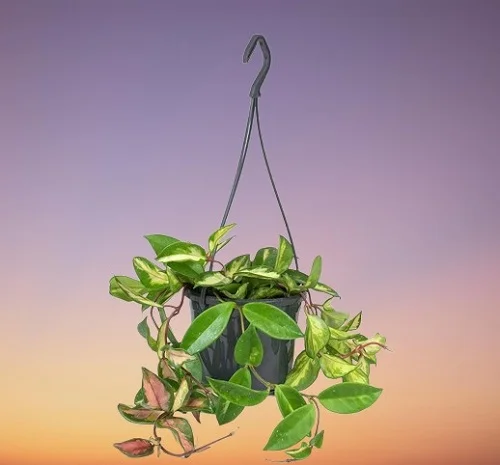
Wax Plant also called Porcelainflower is an easy to grow, climbing houseplant which bears fleshy leaves and clusters of waxy, fragrant, star-shaped flowers.
The twining stems in Wax Plant can reach 15 ft or more making it an excellent plant for a hanging basket or a trellis.
Hoya carnosa is one of the Hoya varieties and are referred to by many common names like Waxplant, Waxvine, Waxflower, Porcelainflower or simply Hoya.
Hoya carnosa blossoms in bright light with with 4-6 hours of direct sunshine, warmth of 16-260C, humidity of 50-55% and moderately moist, rich, well-drained hoya potting soil coupled with monthly feeding during the growing season.
Learn more on how to grow and care for Hoya carnosa
